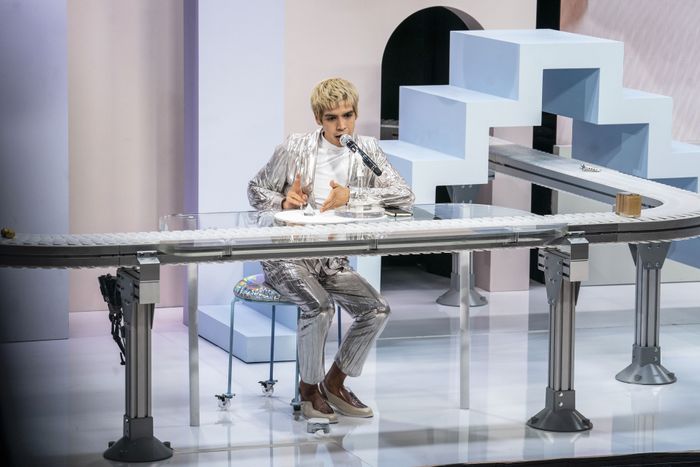
So often, comedy is about defamiliarization. It’s the gambit that gets loved (and lovingly mocked) in a Seinfeld-esque opening that begins, “So what is the deal with brunch?” It’s the structure underneath less direct jokes like Nate Bargatze’s delightful “dead horse” sequence and the premise that powers Ali Wong’s tweeting about the necessity of hooks in bathroom stalls. The idea is to take some thing that will be widely recognizable to everyone in the audience, and then carefully render that thing alien, surreal, and newly visible so the audience can see exactly how strange and hilarious it is. It’s how an impression works, too — a collection of well-known but normal-seeming quirks suddenly become magnified, exaggerated, more absurd, and more obvious. It’s how most criticism works, too; a good critic finds all the things in a TV show you noticed but never really saw before, and makes them less familiar so you can see them clearly.
A comedian can perform that defamiliarization with words. “What’s the deal with …”; “Have you ever noticed …”; “Yesterday I was a the store and I saw …”; etc. Or, in the case of Julio Torres’s My Favorite Shapes, that same process could be performed by donning an iridescent, futuristic silver suit, sitting in front of a conveyor belt powered by a foot pedal, and proceeding to examine and discuss a series of everyday shapes and objects.
There is a square. There is a tiny cactus inside a tiny glass pot. There are dioramas and tiny glass birds. There is what I am almost positive is a McDonald’s Happy Meal toy from the ’90s that was meant to look like an anthropomorphic chicken nugget, and which has now been removed from its nuggety context and made to stand all on its own on Torres’s galactic conveyor belt. Torres names this object “Eric.” Eric is a brown, oblong plastic blob with lidded eyes and a disconcerting smile, and Torres roundly dismisses him before introducing Eric’s female counterpart, Krisha. Eric sucks, Torres explains. But Krisha? Krisha is amazing.
The design of Torres’s show is strange and disorienting. There’s the geometric, neon-lit set; the closeup shots of his hands as he manipulates the objects; Torres’s no-nonsense, often blank expression as he tells you about the process of transferring a soul between two plastic seahorses as though that were a completely regular event. But the deep idea of it is simple, even childlike. Like a kid playing with toys, Torres approaches shapes and objects as individual personalities, with names and histories and preferences. Sometimes they’re metonyms, and the genius of holding up a red-orange circle and a white triangle and telling you one is Fred Flintstone and one is Wilma is one of those bolt-from-the-blue ideas that is ticklishly infectious. Sometimes they are personal histories. The engine of the hour is Torres’s capacity to imbue objects with personalities, and fittingly, some of them represent stories from his own childhood. A capital letter “E” with too many spokes in the middle, for instance, from when school-aged Torres didn’t understand why some of his E’s couldn’t happen to be particularly well-accessorized.
More often, though, they are full-fledged stories about objects, sometimes so detailed that they become breakout segments of their own. The tiny cactus gets his own brief inner-monologue, voiced by Lin-Manuel Miranda, telling the story of his sense of foreboding about the little glass pot’s previous resident. One particularly mournful bit features Ryan Gosling voicing the thoughts of a tiny blue penguin, stuck inside an automated toy and made to perpetually march up a set of stairs and then zip down a slide. It is hilarious and heartbreaking to imagine, in Torres’s framing, a blue penguin who has awoken to the cruelty of his fate, stuck forever between his red and black compatriots, never able to trade positions.
Torres’s act of defamiliarization strips an object down by removing it from its usual context, but when he reconstructs the object’s new story, he typically does so by tacking on new, utterly strange, left-field explanations. They’re often rooted in references from his childhood, like movies and TV shows he would’ve been watching at the same time he would’ve been playing with these toys and giving them inner lives. And in spite of his deadpan delivery and grave introduction of each new object as if it were the next stop on the tour of a world-famous museum, most of the objects and their backstories are deliciously personal. It’s the kind of dishy gossip you’d be thrilled to hear about a near acquaintance, but here, it’s a story about a particularly snobby curtain. From the disorientation of defamiliarization comes sudden, funny intimacy. If it weren’t being presented inside a protective veil of iridescent strangeness, it’d be easier to see how vulnerable and tender it all is.
My Favorite Shapes will work not for everyone. There is a high bar of weird to clear in order to enter into its world, and Torres has little interest in toning anything down or making himself or his ideas more accessible. It’s not a show that an algorithm might produce or something that looks a little bit like lots of other things and can be sold on broad appeal. That’s precisely what makes it tick, of course — the unwavering commitment to the bit, how mannered the show is, how self-possessed Torres is, how deeply he obviously does love his tiny figurine of the villain from the Disney adaptation of The Hunchback of Notre Dame. But for those who are really tickled by Torres’s comedy, the special will become exactly what one of those precious, beloved objects is to him: something resoundingly idiosyncratic, with a personality that not everyone can see. Once you see it, though, you will not forget it.





